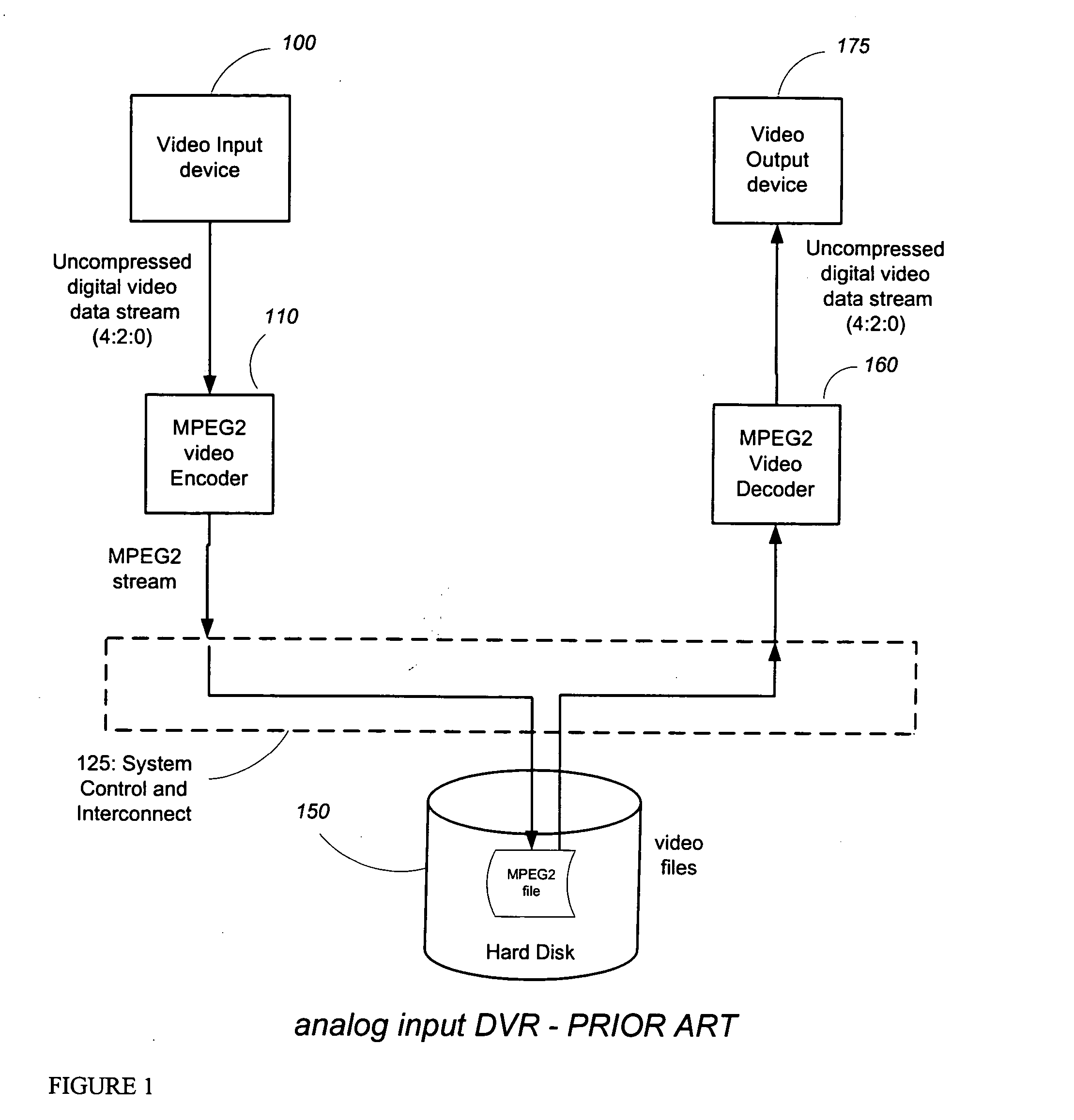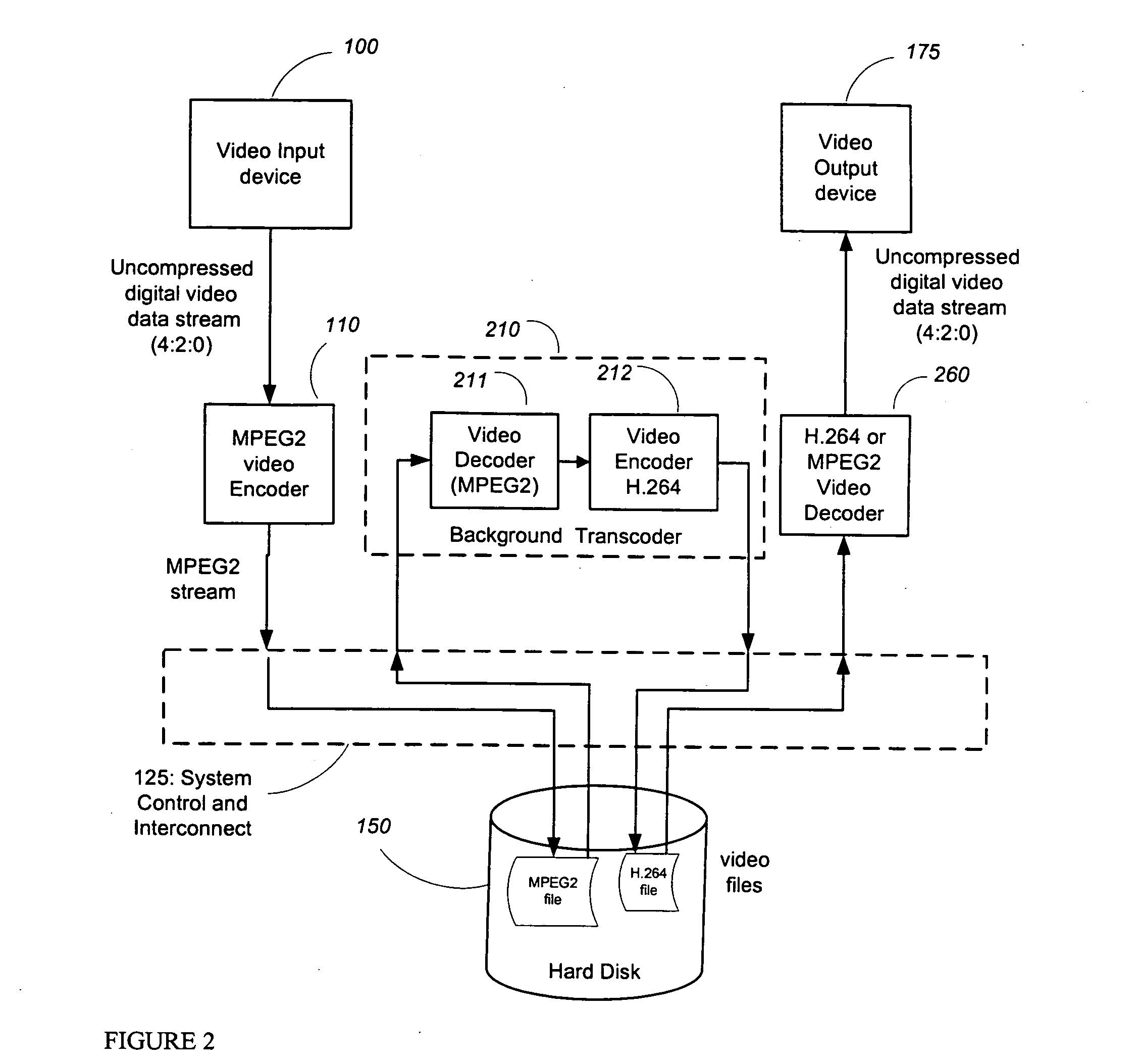Digital video recorder with background transcoder
a video recorder and background technology, applied in the field of digital video recorders, can solve the problems of direct affecting the cost of units, fixed and relatively unimportant, and achieve the effects of reducing the number of video files, increasing the total computation per second of video, and reducing the size of hard disks
- Summary
- Abstract
- Description
- Claims
- Application Information
AI Technical Summary
Benefits of technology
Problems solved by technology
Method used
Image
Examples
first exemplary embodiment
[0044] A first exemplary embodiment of the invention is a stand-alone Digital Video Recorder (DVR) unit for home use. It is an improvement on the prior art just described. This unit is intended to provide a maximum amount of video storage, measured in hours, at a low price. To this aim, the DVR unit is described herein with just the fundamental features of a “personal” video recorder; it is assumed that many other features, such as an electronic programming guide, could be included in such a product, depending on the final price range of the unit.
[0045]FIG. 2 is a block schematic showing the data flow through the stages of the first exemplary embodiment. As illustrated, television signals enter the system from live broadcast through the video input device 100, which typically includes a TV tuner and an NTSC decoder. The video input device 100 provides uncompressed digital video to the first video encoder (e.g., MPEG-2 encoder) 110. The first video encoder 110 compresses the video t...
first embodiment
Flow Chart of Operation (First Embodiment)
[0052]FIG. 3 illustrates the sequence of events that occur in the DVR system of FIG. 2. As is now conventional for VCRs and DVRs, the system is programmed by the user to record television shows at prescribed times. Accordingly, at step 301, the user specifies the time and channel of the show, either directly (using a remote control and an on-screen menu) or indirectly (by identifying the show by name on an on-screen program guide). At the prescribed time, the DVR tunes the tuner to the prescribed television channel and begins the recording process (step 302). The video encoder 110 compresses the incoming video to MPEG-2 in a conventional manner using the video processing resources to provide a first compression (1) at step 303. The compressed video (1) is written to the hard-disk 150 at step 304 as soon as it is generated. Recording proceeds until the video program ends. The user can select to playback the file at anytime, even while it is b...
second exemplary embodiment
[0054] A second exemplary embodiment includes a digital set-top box (STB) with a built-in hard-disk for video recording in accordance with the techniques of the invention. In such an embodiment, the STB receives a signal that is already compressed into MPEG-2. Because of this, DVR functionality can be added to a STB in a straightforward way. Indeed, most of the DVRs that are available today are built into STBs for either digital-cable or digital-satellite television services. Such a box does not require a video encoder, since the signal is already MPEG-2. This both lowers the price and increases the quality of the DVR recording. This increased quality comes from the fact that the MPEG-2 encoders used at the head-end of the cable or satellite delivery system are very expensive and of very high quality. They achieve a very low bit-rate (compared to consumer MPEG-2 encoders) and a good picture quality.
[0055] Still, it could be desirable to lower the bit-rate even further for the purpo...
PUM
 Login to View More
Login to View More Abstract
Description
Claims
Application Information
 Login to View More
Login to View More - R&D
- Intellectual Property
- Life Sciences
- Materials
- Tech Scout
- Unparalleled Data Quality
- Higher Quality Content
- 60% Fewer Hallucinations
Browse by: Latest US Patents, China's latest patents, Technical Efficacy Thesaurus, Application Domain, Technology Topic, Popular Technical Reports.
© 2025 PatSnap. All rights reserved.Legal|Privacy policy|Modern Slavery Act Transparency Statement|Sitemap|About US| Contact US: help@patsnap.com



